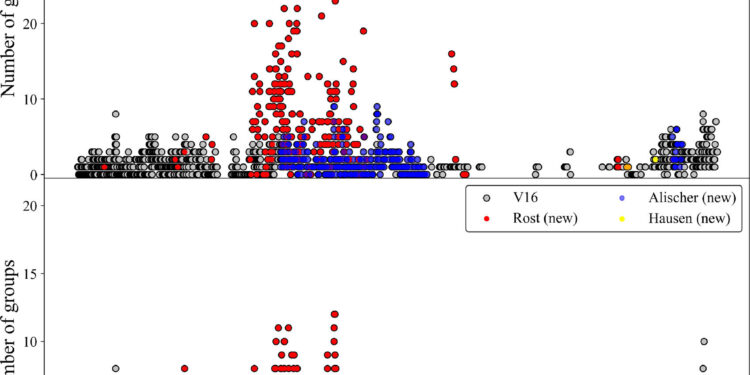(Top panel) Daily counts of sunspot groups recorded by all contemporary observers included in the sunspot group database of Vaquero et al, 2016 (V16) for the period 1716–1726. (Bottom panel) Same graph but applying the sunspot group counts from this paper to the sunspot records made by earlier observers. Credit: The Journal of Astrophysics (2024). DOI: 10.3847/1538-4357/ad3fb9
How accurate are past records of sunspots? In a new study published in The Journal of AstrophysicsA team of multinational researchers looked at historical data and found that after the unusual period of near-absence of sunspots, a period called the Maunder Minimum, the transition to a more normal number of sunspots was not as abrupt as previously thought.
This discovery has implications for understanding the solar dynamo, the physical processes in the Sun that create its magnetic field, and the Sun’s influence on Earth.
Sunspots, dark dots on the Sun’s bright surface, are useful to scientists as indicators of the Sun’s internal processes and emissions. Astronomers began recording sunspot numbers as early as 165 BC, although there were interruptions in the Middle Ages and the 15th century. Systematic counting of sunspots by telescope began in the 16th century, and the Centre for Analysis of Data on Solar Influences at the Royal Observatory of Belgium has kept a record of the monthly average number of sunspots since 1749.
Sunspots are useful for predicting space weather, conditions in the ionosphere, the solar dynamo (the physical processes in the Sun that generate its magnetic field), and as an indicator of solar output, which in turn determines how much solar energy strikes the top of Earth’s atmosphere, which can influence Earth’s surface temperatures and global warming.
One of the most interesting periods in sunspot history was the Grand Solar Minimum, known as the Maunder Minimum, a period from 1645 to 1715 that saw a rare dearth of sunspots, in some periods their numbers reaching as low as 0.1% of those observed in modern times.
The Maunder Minimum was once thought to be linked to the Little Ice Age (LIA), a cold period in parts of the Northern Hemisphere that occurred from the early 14th century to the mid-19th century, but in recent years scientists have discovered that the cause of the LIA was primarily volcanic activity in the 13th century.
Sunspot activity then returned to “normal.” Nothing comparable to the Maunder Minimum has been observed in the age of telescopes, not even the Dalton Minimum, observed between about 1790 and 1830.
“We found that the recovery of solar activity after the Maunder Minimum may have been more gradual and less intense than previously thought,” said Victor Carrasco, lead author and research assistant at the University of Extremadura in Badajoz, Spain. “Prior to our study, it was thought that the transition from the end of the Maunder Minimum to the period of ‘normal’ solar activity was abrupt. This finding has important implications for solar dynamo models.”
The group reexamined data from contemporary sunspot observers, including those of German astronomers Johann L. Rost and Sebastian Alischer, during the 11-year period from 1716 to 1726. Many of these old records were transferred to databases by later observers, many of which are now online.
Looking closely at these and other records, including drawings of the sun’s surface by Johann Christoph Müller, they immediately suspected that Rost’s recorded values seemed confused. In particular, they thought that Rost, who made the largest number of records, may have confused the counts of individual sunspots with the counts of sunspot groups.
Sunspot groups are single entities that can include several sunspots close together; they are easier to see, so fewer of them would go unnoticed. Rost’s survey also showed that most sunspots appeared in the sun’s southern hemisphere.
Rost had recorded textual information in his archives, numbering and listing the sunspots he had observed, as well as diagrams showing their positions on the solar disk. By recounting the sunspot groups, the team defined sunspot groups where Rost had described a sunspot group, which was not an easy task because Rost did not always clearly indicate the distances of each sunspot group.
The researchers found significant differences. For example, the first solar cycle after the Maunder Minimum had a maximum number of sunspot groups of 12, compared to previous studies. The shape of this cycle became more evident, with an ascending phase reaching a maximum number of groups in 1719-1720, then a descending phase until about 1724, followed by an ascending phase of the new solar cycle.
They were even able to count a greater number of observation days than Rost and Alischer, because the information provided by the latter two allowed them to determine the existence of sunspots, even if the exact number of groups was undetermined. They also discovered that hemispherical symmetry had been recovered.
Why are these details important? “Solar dynamo models incorporate ‘intermittencies’ in solar activity, meaning that there are periods of greatly reduced activity that are randomly interspersed with intervals of ‘normal’ cyclical activity,” Carrasco explains. “The Maunder Minimum is often cited as an example of such quiescent periods. Our results change ideas about how solar activity behaves during these transitions and improve our understanding of its long-term behavior.”
The group hopes that this work will improve the research of solar modelers and that others will also be motivated to discover sunspot records not yet included in databases, particularly from the 18th century, when observational coverage was quite low during some periods.
More information:
VMS Carrasco et al, Understanding solar activity after the Maunder Minimum: sunspot records by Rost and Alischer, The Journal of Astrophysics (2024). DOI: 10.3847/1538-4357/ad3fb9
© 2024 Science X Network
Quote:Corrected sunspot records show that the Maunder Minimum did not end abruptly (2024, August 20) retrieved 2024 August 20 from
This document is subject to copyright. Apart from any fair dealing for the purpose of private study or research, no part may be reproduced without written permission. The content is provided for informational purposes only.



